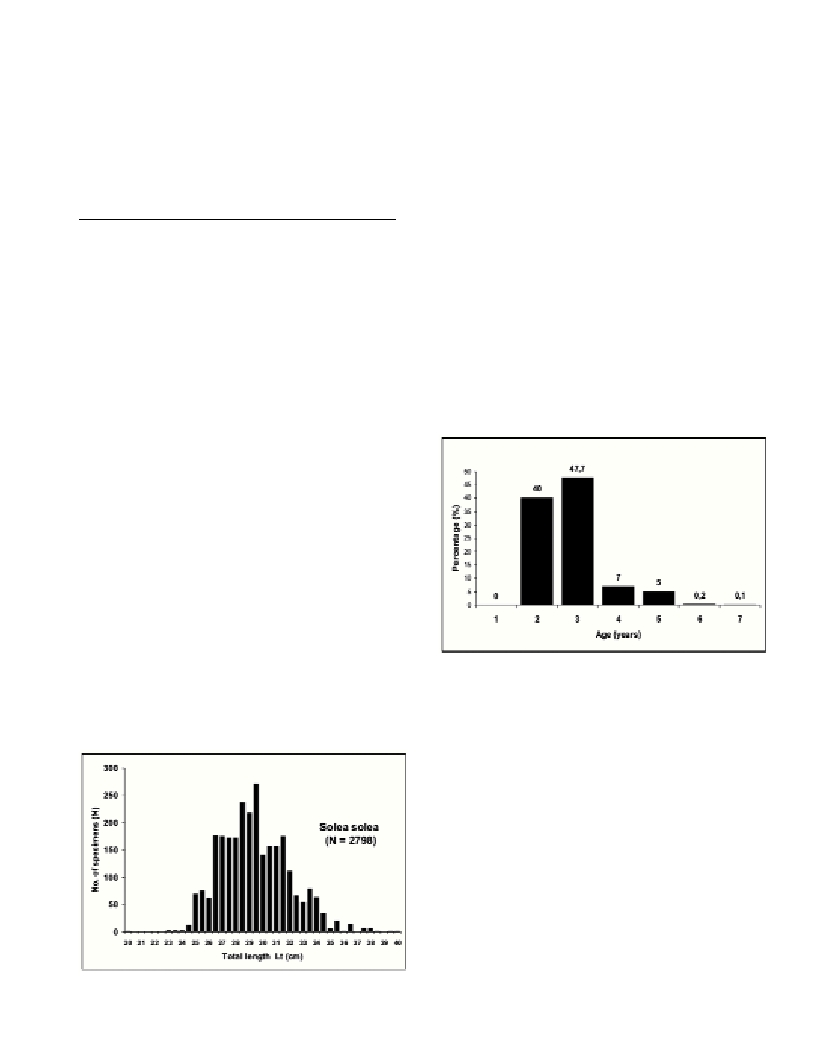FISHING OF THE COMMON SOLE, SOLEA SOLEA (LINNAEUS, 1758) IN THE EASTERN ADRIATIC SEA
Soldo A. *, Cetinic P., Dulcic J., Jardas I., Kraljevic M., Pallaoro A., Matic Skoko S.
Institute of Oceanography and Fisheries, Split, Croatia - * soldo@izor.hr
Abstract
Common sole Solea solea(Linnaeus, 1758), is one of the most important commercial species in the Eastern Adriatic Sea. It is widely
distributed throughout sandy and muddy bottoms of whole Adriatic, but its greatest occurrence is in the northern part. A total of 2.798
specimens of the common sole were caught by trammel nets in the period December 2002 – February 2003. Total length (TL) ranged from
20.0 to 39.8 cm (mean = 29.38 cm, SD = 2.49) and age from 2-7 years, with the 2- and 3-year old individuals dominating the samples
(87.7 %).
Keywords: common sole, trammel net, fishing, total length, age
Rapp. Comm. int. Mer Médit., 37,2004
442
Introduction
The common sole, Solea solea(Linnaeus, 1758) is a demersal fish
species preferring muddy and sandy bottoms. It occurs also in
estuaries or even in the lower parts of the rivers. Juveniles frequently
appear near shores, while adults can be found even at depths of 250
m. Spawning starts offshore at the end of autumn or early in winter
(1). It is one of the most important commercial species in the Adriatic,
especially in its northern part, which is the main fishing area of the
species caught by scallop dredges, bottom trawls, gillnets and
trammel nets. The later are the main fishing gears for the species and
according to the Croatian fishery legislation their use is prohibited
during the period 1
st
of June - 1
st
of September.
Material and methods
Samples were collected from the western coasts of Istrian peninsula
(eastern part of the Northern Adriatic), using commercial fishermen,
at depths of 20 - 40 m, during the period from December 2002 through
February 2003. Trammel nets were of twisted multifilament
polyamide, with mesh sizes of 80 and 320 mm (stretched mesh) in the
inner and outer panel, respectively. Generally, a series of trammel nets
used were consisted of 18-20 single, 18 m long, nets of 1 m height.
For each specimen the total length (TL, to the nearest mm) and weight
(W, to the nearest g) were measured. Age was determined by reading
otoliths.
Results and discussion
During the investigated period a total of 4989 specimens of fish and
other marine organisms were caught by trammel nets. Overall, 49
different species were recorded (40 fish, 3 cephalopods, 5 crustaceans
and 1 shellfish). 2798 individuals of common sole were caught
representing 70.9 and 70.4% of the total catch by number and weight,
respectively. The second most abundant fish species was Merluccius
merluccius (4.0% of the total catch by number and 3.0% by weight).
Other sole species,Solea kleini, Solea nasutaand Solea imparwere
caught sporadically. Cuttlefish, Sepia officinalis,consisted 7.1% of
the total catch by number and 11.7% by weight. Squilla mantiswas
the dominant crustacean species (7.9% and 2.4% by number and
weight, respectively). Weight of caught common sole specimens
ranged from 62 to 592 g (W ±SD = 228.9 ±76.92 g). The total length
of common sole ranged from 20.0 to 39.8 cm (Fig. 1). The average
length (29.38 ±2.493 cm) was higher then that reported for the same
species caught by gillnets in the western parts of the Northern Adriatic
(2). The age of common sole specimens were 2 to 7 years old (Fig.2).
The 2- and 3-years old classes were the most abundant (87.7%). The
comparison of these results to those from gillnets, suggests that
trammel nets of 80 mm mesh size are much more selective than 64-68
mm mesh size gillnets. Moreover, gillnet research reported large
percentages of specimens under the minimum legal size of 20 cm (9-
30% depending on season), while in trammel nets such small
specimens were not found. An explanation could be that gillnets used
at the western parts of the Northern Adriatic are characterized by
small height (2-2.5 m) and very low buoyancy of ?oats, that allow
gillnets to lay on the bottom and therefore catch common sole in a
manner similar to trammel nets, but with considerably smaller mesh
sizes.
References
1-Jardas I., 1996. Jadranska ihtiofauna. Školskaknjiga d.d., Zagreb,
536p.
2-Grati F., Fabi G., Lucchetti A. and Consoli P., 2002. Analisi delle
catture di Solea vulgarisQuensel, 1806 effettuate con reti ad imbrocco in
Adriatico settentrionale. Biol. Mar. Medit.,9 (1): 154 - 160.
Fig. 1. Total length frequency distribution of Solea solea(Istrian
Peninsula), December 2002 - February 2003.
Fig. 2. Age composition of Solea solea(Istrian Peninsula), December
2002 - February 2003.

